“Nian (Year) was a ferocious beast who would come out once every twelve moons, cause destruction and kill everything that crossed its path. However, Nian was afraid of the color red. So people put red strips of paper around their door frames so the destructive beast would pass over their house when it saw red on the door frame….”
This was the first story my dad told me about Chinese New Year and the tradition behind putting chun lian — red strips of paper with words of blessing on it – around the door frame.
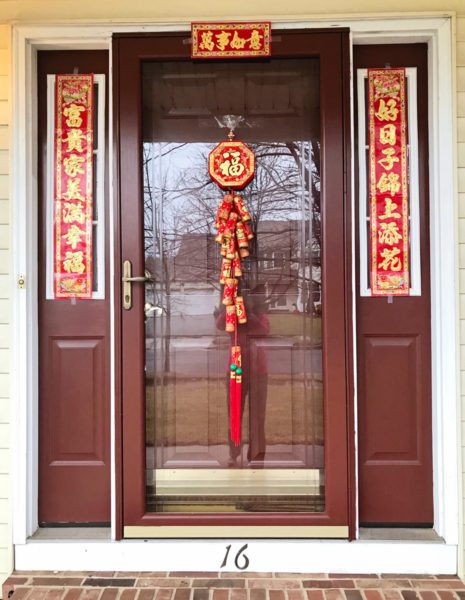
Then my devout Christian-minister father would ask, “Do you know where this story really came from? It’s from Exodus in the Bible, and chun lian was supposed to represent the blood of a lamb, so the angel of death would pass over each door with the blood!” (The Chinese version of Passover?)
The rest of the story of the Nian beast was that it was scared of the sound of firecrackers, so people would set off firecrackers to scare Nian away with the loud noise. After surviving the passing of Nian, people would congratulate each other, celebrate by wearing red clothes, and eat! This is called Guo Nian, literally meaning passing another year (Nian), or crossing into the new year, the biggest holiday in Chinese tradition.
It is also known as the Spring Festival or simply Chinese New Year.
I grew up in a Christian home in Taiwan (a small island off China’s southeastern coast with a different government but a culture similar to China). Christians are a small minority comprising only two percent of the population, and we didn’t celebrate much of Chinese New Year. It may be because my father didn’t want a Christian, modest family like ours to engage much in the cultural practices around us, like worshiping ancestors and the excessive spending and gift-giving during Chinese New Year.
Nevertheless, I do remember going to relatives’ homes for New Year’s Eve dinner, which I did not enjoy because it was all grown-up talk and not much to watch on TV except for New Year specials consisting of cheesy singing and saying blessings to one other. What I did enjoy was the occasional receiving of the “red envelope” or hong bao (containing money) from elder relatives and friends. This was a treat to receive, with the anticipation of how much was in the envelope and spending the money afterwards.
Reaching adulthood, especially after I came to the US for graduate school and beyond, Chinese New Year became an annual opportunity to get together with other students and colleagues from many Chinese cultures (China, Taiwan, Southeast Asia, etc.). We would occasionally have some kind of celebration with a talent show, but the main activity was always eating.
It was interesting because we got to experience how others celebrate Chinese New Year, e.g., the different kinds of food people eat during the festival — like my first taste of chive paste. I still remember that pungent and delightful surprise on my taste buds the first time I tried it as a condiment for “hot pot” during one of the Chinese New Year celebrations.
Hot pot is a meal where you cook your own food (thinly sliced raw meat, veggies and a variety of meat balls and dumplings) in a pot of boiling broth in the center of the table. I grew up having hot pot in winter, but I think it’s more of a northern China tradition where people include hot pot in the New Year’s Eve dinner. The best part of hot pot, in my opinion, is not the food, but concocting the elaborate sauce of your own creation to dip your food in. My schoolmates from northern China taught me there are many more condiments for making hot pot sauce than what I knew growing up in Taiwan. And there is endless fun (and sometimes surprises) trying the different combinations of soy sauce, sesame oil, a special barbecue sauce called sha-cha, chive paste, diced scallion and garlic, just to name a few.
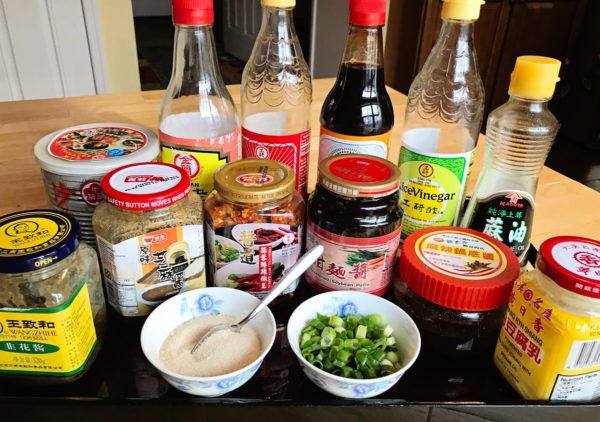
If you don’t mind dipping your food in each other’s sauce dish, you can compare your own and others’ creations, which can turn the dinner into a fun and competitive game.
When I met and started dating a Caucasian, I was not sure how a cross-cultural relationship would work out. But he really was a Chinese-culture loving guy — I was very impressed the first time I went to his house and saw that he had a whole pantry of Chinese condiments, enough to hold a hot pot party. I eventually married him and took over that Chinese kitchen, which he does not use much anymore since we got married!
My husband loves traditions. After bringing two children home from China we’ve tried especially hard to keep the traditions of Chinese New Year and other Chinese festivals alive, which really means eating the right foods on the right holidays. Unlike “moon cakes” for the Mid-Autumn festival and zongzi (sticky rice wrapped in bamboo leaves) for the Dragon-Boat festival, in which only one major food item is needed to represent the holiday, Chinese New Year has many more “must eat” foods besides hot pot.
It’s important for Chinese to have good luck in the New Year, so all the dishes have symbolic meanings representing good fortune. For example, hot pot symbolizes reunion and warmth — the pot is round (yuan in Chinese), with the same character appearing in the word for reunion (tuan-yuan). The pot is usually heated on a small table-top stove so its fire creates warmth for the dinner guests.
Some other dishes we try our best to include in our Chinese New Year dinner are:
1. Dumplings. These are shaped like ancient Chinese gold ingots used as money, therefore they symbolize prosperity. Some people even wrap a clean coin in one dumpling and whoever gets that dumpling is considered extra lucky in the New Year – just be careful not to bite too hard in case you bite into a coin!
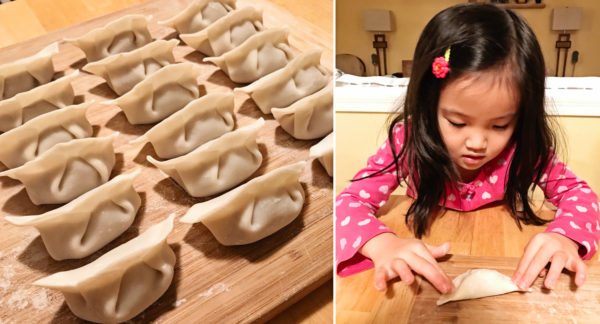
Although I never learned to make our own dumpling wrappers (skins) from scratch like many Northern Chinese do, as a little girl I learned how to make dumplings using store-bought wrappers. Therefore, the dumplings I made would be consistent in shape and look like little gold ingots standing uniformly row by row. However, an amateur might find his dumplings not shaped like anything, and they may even fall apart during cooking.
But it’s always a lot of fun having a dumpling-wrapping party and seeing whose dumplings withstand the test of boiling. (A couple tricks: don’t stuff too much filling in the wrapper, and squeeze as much water as possible out of the veggies in the filling.) My daughter is turning five this Chinese New Year and I think it’s time for her to carry the family baton and learn how to wrap dumplings!
2. Fish. Fish in Chinese is yu, which sounds the same as “surplus” (though it’s a different character). When you include fish in every New Year’s Eve dinner, you’re saying you have surplus year after year.
Traditionally, people would like to have a whole fish on the table. But as long as it’s yu, a simple fish filet will suffice for a Chinese-American family (plus we don’t have to worry about those little bones in a whole fish).
3. Year cake (rice cake) or nian gao.
This is another play on words in Chinese, because “cake” in Chinese is gao, which sounds like the character for “higher” or “taller”. “Year cake” would sound like becoming higher (promoted) each year.
Nian gao comes in many types. One type we often have usually comes as little white oval slices, is sautéed with meat and veggies and served as a main dish. There’s also sweet rice cake that comes in a block, mixed with red beans, peanuts or dried fruits. This needs to be sliced and cooked, usually dipped in a flour and egg batter and pan-fried. It can be served as a dessert or for breakfast.
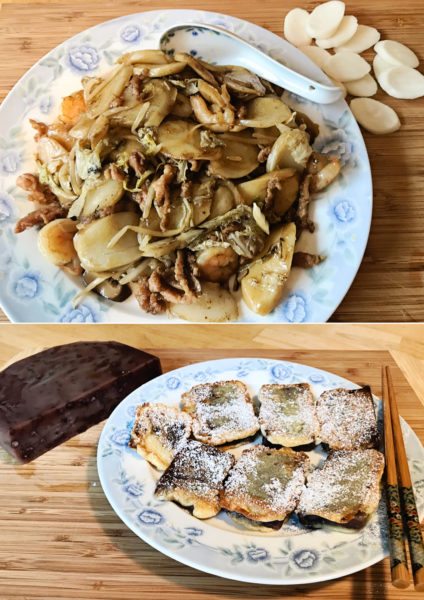
A few years ago (long before either of our adopted children came home), my journalist friend invited me to share in a local Chinese newspaper how a cross-cultural family like ours celebrates Chinese New Year. We shared about our annual greeting card that year, when Christmas and Chinese New Year were less than a month apart. So our card was designed to express the biggest holiday in both cultures: with both chun lian and a Christmas wreath, and wearing our Chinese outfits and a Santa hat on my husband’s head.
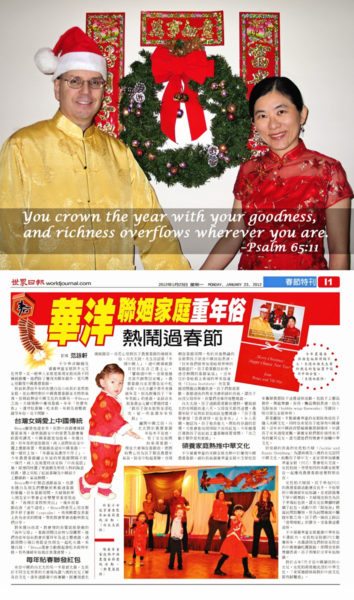
Some Chinese send greeting cards for Chinese New Year just like Christmas cards. So we used our card for two holidays and could send it out over a month’s span, which was convenient because we often send our Christmas cards late anyway.
In the same issue of that Chinese newspaper featuring cross-cultural families was another story about American families who’ve adopted children from China. It told how these families get together to create a Chinese-culture-infused festival to teach their adopted children about the culture of their birth. These parents talked about how especially comfortable they felt celebrating the holiday together with other adoptive families. Little did I know that one day we would also join those adoptive parents with China babies, and share that longing and satisfaction to be in a community with others from similar situations, who “get it.”
Recently I read an article about a Chinese adoptee who felt her parents were “pushing Chinese culture down her throat.” In fact, many immigrant children also feel that way. While I understand the confusion one might feel having a cross-cultural identity (for I share that confusion sometimes myself), I believe the point of celebrating Chinese New Year is not really about learning the culture, but to have a sense of belonging and community. It’s about togetherness and family. That’s why ever since we brought home our first child from China, we chose to celebrate Chinese New Year with other adoptive families.
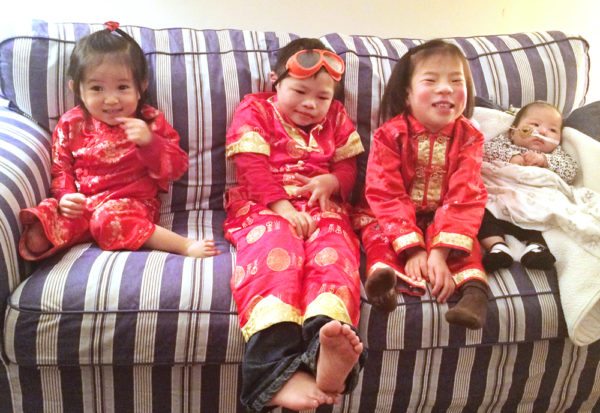
We each have our own unique adoption stories, but we feel like family. Not only do we share a common bond of having adopted Chinese children, we understand the struggles, challenges and triumphs we face as adoptive families each passing year.
Whether it’s the Jewish Passover to celebrate escaping the passing angel of death and liberation from Egyptian bondage, or the Chinese Guo Nian to celebrate surviving the ferocious and destructive beast Nian and the new hope and life of another new year, the meaning behind these holidays can probably resonate with us all. We’ve seen the trauma and destructive nature in our children and even ourselves, yet we have hope that because we’ve survived another year and learned lessons from our mistakes, we’ll be delivered further from the past that enslaved us, and welcome a new hope and mercy that God has promised us in each New Year and each new day.
So whether you choose to celebrate Chinese New year by a food extravaganza, sending Chinese greeting cards, spending time with families and friends whom you feel most comfortable with, or simply telling the stories behind the tradition, we would like to offer you a New Year bow (we call it bai nian in Chinese) and wish you Gong Shi Fa Tsai (congratulations and be prosperous), and Happy New Year!
– guest post by Yih Pai

























Leave a Reply